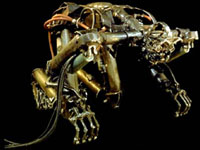Is the goal of robotics to create obedient slaves?
The word "robot" is derived from the Slavic word for 'work'. Much has been said about robots freeing us from our mundane tasks, and liberating humanity, but it is interesting to consider another linguistic parallel. Namely, the German word for work "arbeit", which appeared on the gates of Auschwitz - "Arbeit Macht Frei" or "Work will make you free."
Like all technological advances, the question arises, "Who will ultimately be enslaved? The Creation, or the Creator?"
It is said that the moment when the creator loses control of the creature is a necessary step towards its advanced development. When it becomes independent. Scientists are trying to provide robots with an independent decision-making capability - to act artificially intelligent. But this opens a Pandora's box. Once we give the robot this freedom, we may not be able to anticipate all of the consequences. In artificial intelligence, success is often declared at the moment when the program or robot is capable of surprising its creator.
There is no more surprising creature than man. This leads us to questions about our Creator that have been posed by religion for as long as we know.
 For instance, one might ask the question of man's "fall" from grace
in the Garden of Eden, "Did he fall, or was he pushed?" God, being omnipotent,
logically would have HAD to know that man would disobey him, so why did he allow it? The
question of free will has vexed theologians for millennia, but perhaps God knew that in
order to develop into beings worthy of sitting at his right hand, God would have to let us
wander the wilderness. Or in the words of the immortal Sting, "If you love someone,
set them free." The Kabbalah goes so far as to say that God, and the Devil who tempted
us, are one in the same. For He knew that only after struggling and eventually defiantly
confronting all of Satan's temptations and overcoming them, could we be completely
cleansed of worldliness and become divine beings.
For instance, one might ask the question of man's "fall" from grace
in the Garden of Eden, "Did he fall, or was he pushed?" God, being omnipotent,
logically would have HAD to know that man would disobey him, so why did he allow it? The
question of free will has vexed theologians for millennia, but perhaps God knew that in
order to develop into beings worthy of sitting at his right hand, God would have to let us
wander the wilderness. Or in the words of the immortal Sting, "If you love someone,
set them free." The Kabbalah goes so far as to say that God, and the Devil who tempted
us, are one in the same. For He knew that only after struggling and eventually defiantly
confronting all of Satan's temptations and overcoming them, could we be completely
cleansed of worldliness and become divine beings.
The Frankenstein archetype generally describes a human who creates a creature that comes to life. Initially the creator takes great pride and delight in the creature, until at some point the creature takes a life of its own or otherwise runs amok, and in the end, the creator pays the consequences for this act of hubris. Interestingly, and not coincidentally, it is rarely a woman character who creates life in such a way, since she has the capacity to create life inherently - naturally.
In the Jewish myth of the Golem, after the creature does what it has been commanded to do, the Rabbi tricks it into leaning close enough that the Rabbi can erase the first letter inscribed on its forehead, thus changing Emet (Truth, or Life) into Met (Death), and the Golem turns into a lifeless mass of clay which crushes the Rabbi to death. Again, harsh consequences for the creator. The rabbi's fatal error was to forget to specify what computer scientists call a "termination condition".
As modern example of this, was the shock and horror of the physicists on the Manhattan Project when they witnessed the awesome destructive power of the atomic bomb. By then it had gotten away from them and some, most notably Oppenheimer, suffered a Promethean downfall. Perhaps the lessons we might learn from this is to temper our learning with compassion and wisdom, otherwise we will destroy ourselves.
It is pure hubris, the hubris of Scientism (an irrational belief in the truth of science above all else), to think that we will be able to foresee all the possible contingencies and prepare for them adequately. In the end, we are not God, no matter the miraculous technology we command.
In this light, it is interesting, and more than a little disturbing to note that the Defense Departments Advanced Research Projects Administration (DARPA) has designated it's robotics research program as the Genetically Organized Lifelike Electro Mechanics, or "Golem Project."